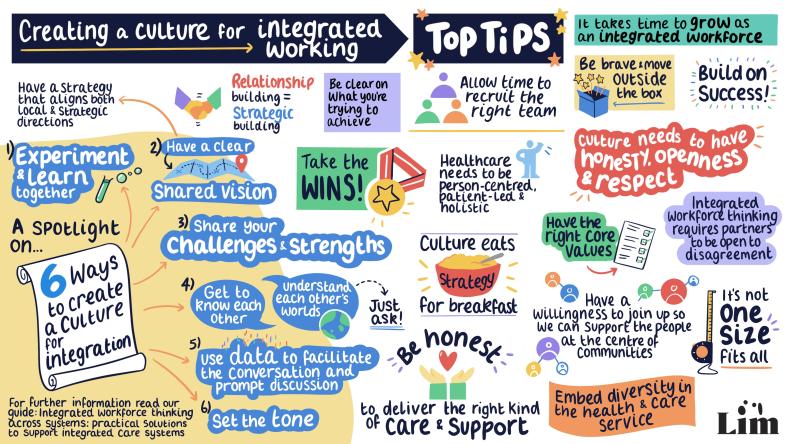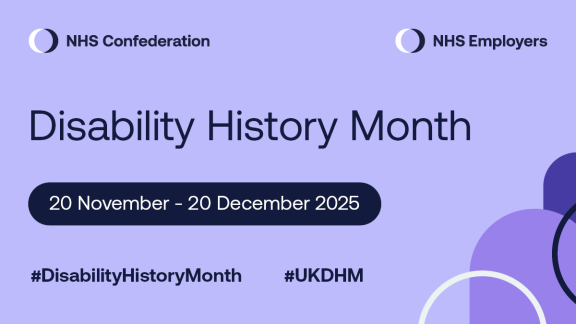
Background
It's important to acknowledge that integrated care systems (ICSs) are at various stages of development. What unites all ICSs is the need for individuals from different organisations to work collaboratively to create a culture where integration can thrive. We have been engaging with partners across health and social care to learn what is most important in attaining a positive culture, how we can bring it to fruition, and how we can benefit from hearing and working with the diverse roles across our sector. Our six ways were drawn from systems currently planning and developing integrated working and collated by NHS Employers, Skills for Care (SfC), the Local Government Association (LGA) and the the Association of Directors of Adult Social Services (ADASS).

In October 2022, we published the guide Integrated workforce thinking across systems which offers tips and insights to help system leaders start thinking about integrated working. Since the publication of the guide, we have received feedback from members that building the right culture and creating strong relationships can sometimes be difficult to achieve but presents new opportunities if done well. That is why we have created a resource to prompt thinking and provide the tools we feel are needed to create a better culture that supports collective and collaborative action, working beyond traditional teams and organisation boundaries.
We extended our engagement and collaborated with more partners to explore the impact that peak demand has on people and partnerships, with colleagues from a wide range of organisations/sectors including, community health, acute, primary care, mental health, system organisation development leads, integrated care boards (ICBs), NHS wellbeing leads, residential care, domiciliary care, voluntary sector and the learning disability sector. This collaboration allowed us to bring a wide range of experience and expertise to the table. The quotes detailed throughout the six ways are pulled from our two round table discussions where we discussed how peak demand impacts both the people and partnerships.
In the 2023 Hewitt review into integrated care systems, an independent review of integrated care systems, Hewitt stated that: ‘ICSs represent the best opportunity in a generation for a transformation in our health and social care system. Effective change will require the combination of new structures with changed cultures. Everyone needs to change, and everyone needs to play their part. It is important to create the right culture for integration and encourage health and social care to work together. An integrated approach to health and social care provides people in communities with a better quality of life, rather than a service.’
ICSs are partnerships of organisations that come together to plan and deliver joined up health and care services to improve the lives of those who work and live in their community. Included in ICSs are the integrated care partnership (ICP), ICB, local authorities and place-based partnerships that design and deliver integrated services across their localities or neighbourhoods.
Collaboration is not enough, organisations and the people within them are the system and they need to invest time in building meaningful relationships across different teams and organisational boundaries. Genuine partnerships and collaborative working with shared outcomes can help build a culture that truly improves the quality of life for people who draw on care and support.
"Ensuring we have strong relationships is where we focus our energy, so we know that when things get tough, we can work together effectively."- ICB CPO network member.
Achieving a culture that improves integration and builds trust in the complexity of the health and social care system can be challenging. This resource shares tips on how ICSs and the people who work within them can begin to work towards this goal.
- Download this chapter
- Background
Six ways to create a culture of integrated working
These steps will support you to collaborate across systems and to build meaningful, sustainable relationships with the organisations and the people within them are the system.
- Download this chapter
- Six ways to create a culture of integrated working
Be prepared to experiment and learn together

ICSs are still evolving; therefore it is important to be open to new ideas to find what is going to work for your system. All ICSs vary in population size, health needs, and geographical scale, as well as in rural, coastal, and urban challenges. This means that what works for one ICS might not work for another. Bearing this in mind, it is important to adopt a test and learn mindset, as what works for your system may take some time to achieve. To do this, we must ensure that we move away from a historical way of thinking to become more innovative in ideas and how we work.
It is important that we work together, learn from our mistakes, and share what we do and how it went, to enable others to build on this and make further improvements. Innovation often happens when there’s no budget, where leaders encourage staff to risk trying new things, even if they fail. Being part of a learning community enables us to avoid some of the pitfalls and achieve more than we can on our own. This test-and-learn and share mindset should still be developed on sound governance, but not on restrictive compliance.
“Current policies make people anxious about who is responsible for risks, especially in a crisis. We need processes that encourage shared responsibility instead of shifting blame.” – focus group member.
“During stressful times, people tend to stick to familiar methods out of fear and lack of time, which limits creativity and trying new things.”- focus group member.
“There’s a training gap in how workers and partners see and handle risks, especially during busy times. This includes understanding unusual risks.”- focus group member.
- Download this chapter
- Be prepared to experiment and learn together
Have a clear shared vision

Person-centred care is a key principle that brings services together. From this, it is important to develop a shared purpose and agenda. Developing some objectives around what you want to deliver together can help you create a shared vision. Agree and understand that relying on the same approach will not provide the necessary results for an integrated system. It’s vital to have good leadership and a statement of purpose or vision that focuses on improving integration, working collaboratively and planning together.
This should be communicated clearly through integrated care systems along with shared performance indicators. Partners should embrace and adopt person-centred care as the principle for working together, and this should be the focus for all policy and practice solutions.
Creating a shared vision is crucial as it ensures all partners are aligned and agree on their goals. When partners set a shared goal, they can work together more effectively to achieve it. The pandemic helped break down siloed working, leading to greater collaboration within the health and care system to provide safe and effective care. Feedback has shown that this collaborative approach was successful because everyone was working towards the same goal. However, since then, historical ways of working have resurfaced, creating barriers to integration.
To overcome these challenges, it's important to focus on what each person needs and how to ensure they receive the care and support necessary for a good quality of life. Integrated working is highly beneficial to the workforce as it allows for the sharing of skills and strengths that others may not have.
“Make sure people who access care and support are at the centre of what you do and enabling choice and control.”- focus group member.
“During COVID-19, there was strong unity, but now people are focusing more on their own organisations. It’s important to keep working together.”- focus group member.
- Download this chapter
- Have a clear shared vision
Set the tone

Integrated working allows you to do things differently. We are all limited by our existing experiences so taking a step back to think about different approaches and how working together will encourage a shared sense of identity and belonging.
It’s important to be clear on what we mean, from a language perspective to both colleagues and the individual being supported, to share accurate information, being clear on roles and responsibilities through a shared statement of purpose - avoid it’s not my job and focus on the outcomes for the individual – if this was a member of my family what would be their aspirations.
Maintaining respect so that we don’t lose sight of the strengths and talents that each member of the system can play in supporting someone to achieve their outcomes, including that individual themselves – set this tone in your behaviours.
We need to write the narrative, lead by example and focus on prevention, focus on shared goals around outcomes for an individual. Ensure language is accessible and responsible, with consideration given to the impact of language like “bed blockers” or “corridor care” on morale.
“Its not always important to ensure that everyone understands what we saying, especially the person receiving care or any one part of the system... this can cause a barrier to integrated working.”
Attention should be given to identifying jargon, breaking down system speak, acronym busting and creating effective communication systems. This focus on language should be applied when developing strategies, recording minutes, sending communications, meeting discourse and inviting views and feedback. Integrated working should be anchored on person-centred care.
- Download this chapter
- Set the tone
Get to know each other and understand each other’s worlds

Getting to know one another increases the likelihood of successfully navigating difficult challenges and resolving issues together. Remember that you are planning for the workforce in a complex system and that no one person understands all areas of it.
Everyone has their own map of the local area that they live and work in. For example, some people's maps will put the local hospital at the centre of the map with everything else feeding into the hospital. Other people's maps might put a small social enterprise in the centre and not even refer to the hospital. Both maps are valid based on the perspectives of those who created them. However, when we overlay these maps, we can identify new opportunities for collaboration by recognising each other’s perspectives and service needs.
To make sense of these maps, you need each to understand the other’s knowledge, understanding and different ideas and perspectives. Focusing on the person who draws on care and support and the lives they want to live means creating space and time to understand their individual needs as part of any multi-disciplinary conversations.
“It’s important to spend time getting to know one another outside of peak demand times, do not underestimate the importance of this, go out and shadow a colleague from another sector or look for an invitation to an existing network.” – focus group member
“It just really struck me that most of us have no idea what each other's legal responsibilities are, and the frameworks that govern our practice. This can impact on relationships if you have to start by saying, ‘I can't do this because of X.”- focus group member
“Offer joint training opportunities from leadership programmes, rotational apprenticeships and shadowing, to themed multi-agency networks – it’s a place where you can find out what each other does without any pressure.”- focus group member
Frimley ICB: integrated care in Surrey Heath Place
Over the past ten years, Frimley ICB has sought to change the traditional service-led approach in Surrey Heath Place. They do this with a 'needs, not services and describe, don’t prescribe' holistic and integrated approach for individuals at all points on their care journey, from prevention to discharge. Relationships have been strengthened, the care model refined and it is now truly embedded into local interactions.
Key principles
- Whole person, whole place.
- No door is the wrong door.
- Tell my story once.
- Strengths-based approach and outcomes focus.
What integrated care looks like in practice
Integration is not a service but an approach, a way of working and a culture. Every person referred to community services receives integrated care. Importantly, all community teams are co-located, with a single point of access, hosting community team administrators who can refer patients to co-located duty teams, who then discuss the most suited team member to carrying out an assessment. The model also includes weekly multidisciplinary team meetings for the integrated care team and proactive care, care home and learning disability teams.
What this culture looks like for staff
- Built on a philosophy of trust, confidence, and strong working relationships.
- A can-do culture, with neither service, geographic boundaries, criteria, or funding considerations allowed to get in the way.
- Understanding each other’s roles through training on what other teams do.
- Challenging cases or areas for improvement are discussed openly as a team.
- Co-located teams.
- A sharing of risk and resource between teams.
“To be truly integrated is an approach, not a team. It comes down to a cultural change. Integration is about all community providers and organisations working together seamlessly.” – Integration Lead
Embedding this positive culture of integrated working has taken time, and maintenance has been required to keep these relationships strong. As a result of this collaboration, Surrey Heath Place provides care that is joined up, person-centred, and outcome-focused, supporting people along their entire pathway from prevention to hospital discharge.
Despite the system changes underway in Frimley ICB, staff aim to continue with this model approach to care in Surrey Heath Place that they have spent years developing.
- Download this chapter
- Get to know each other and understand each other’s worlds
Use data to facilitate the conversation and prompt discussion

Gaining insight into the health and social care needs of your community through population health data is an effective approach.
Data comes in many forms and everyone will interpret the data slightly differently depending on their own experience and confidence with using it.
Each ICS is different with different populations and differing needs. Workforce data alongside population health data can help identify workforce gaps and prepare for future demand. Factors such as the presence of rural or coastal areas with high retirement populations may result in increased demand for care homes and hospital admissions for vulnerable patients. Alternatively, if your system consists of more urban areas with higher student populations, the demand for mental health services may be greater.
When we start digging, we can become overwhelmed by the volume of data available from different parts of the system or that some data isn't available or it's collected in different ways. There is value in collective discussion about what data we want and why, getting everyone around the table to have a conversation to increase people’s understanding of the data.
When we expect people to give us data on a particular issue without explaining to them what we are going to do with it, this can lead to a reluctance to share and less effort being made to ensure the data is accurate.
“When we fail to explain what the data means to us and to understand how it may be interpreted differently by colleagues in other parts of the system, misunderstandings can arise, making the data less helpful than expected.”- focus group member
“Trusting relationships are essential for effectively sharing data, as they determine what data is shared, when it is shared, and how it is interpreted.”- focus group member
- Download this chapter
- Use data to facilitate the conversation and prompt discussion
Share your challenges and your strengths

By bringing people together from different parts of the system and providing the opportunity to set out their challenges and strengths, you achieve two important things. It will give you a good sense of where you are across the system and help to create a sense of connection between people as they recognise, they have more in common than they have that is different.
“In sharing my challenges, I found out that lots of people had the same challenges.”- focus group member
“By listening to my colleagues, I discovered strengths I didn’t know I had.”- focus group member
- Download this chapter
- Share your challenges and your strengths
Activities
We've designed a selection of activities for you to explore with your teams and partners, aimed at fostering thoughtful discussions about your culture. Before diving in, we recommend setting clear ground rules to ensure a productive and respectful experience. These activities are versatile and can be carried out either one-on-one or in small group settings.
We want to hear from you
Every system will be at a different place in their journey, from creating a culture for integration to developing a fully integrated workforce plan. Our work relies on your insight and our cross-partnership work aims to identify emerging lessons, challenges, opportunities and best practice. Similar to your journey, the guides we create are an ongoing, evolving process. We want to hear from you to help shape our work and share best practice. Tell us:
- What’s your experience in creating a culture for integration?
- How have you found the implementation of the six ways?
- Do you have any reflections on the six ways? What do you find helpful? What’s missing?
- Are there examples of best practice you would but forward on building a culture for integration?
If you have any reflections, please do not hesitate to get in contact at system.working@nhsemployers.org.
Our work does not seek to provide all the answers but has been designed to support all ICSs to develop new integrated ways of working built on the best collective understanding we have.
Find more on system integration.




